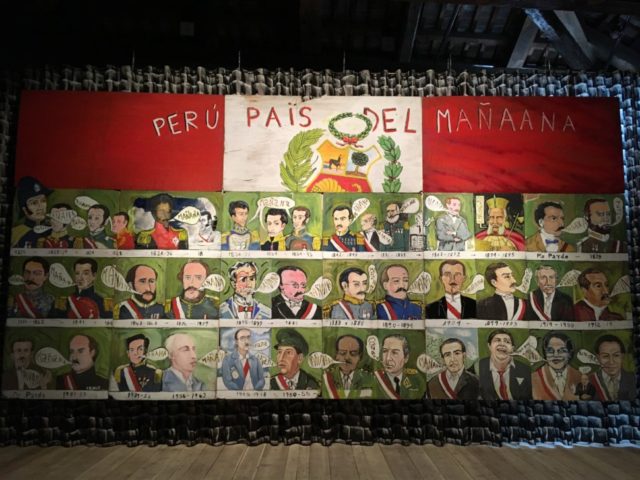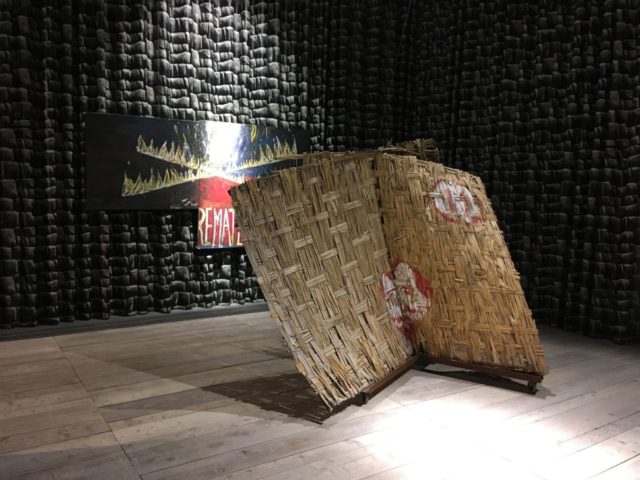Land of Tomorrow. Juan Javier Salazar at the Peruvian Pavilion, Venice Biennale 2017
30 October 2017
“If we are going to create counterculture it should not just be intelligent and dry, but also fun and courageous. Artists should try to perform miracles, not sell paintings to millionaires.”
– Juan Javier Salazar
The art of Juan Javier Salazar (1955 – 2016) reflects the urban popular culture of Peru in a critical, humorous way and by making use of simple, ordinary material. This year he represents Peru at the Venice biennale.
Salazar was a member of the legendary late 70s and early 80s artist collectives Parenthesis and E.P.S. Huayco that both drove Peru’s contemporary art scene towards the ephemeral and non-commercial. One of the latter’s most renowned interventions consisted of a depiction of the popular saint Sarita Colonia made of 12.000 painted milk cans in the sandy hills surrounding Lima (see Lo chicha in de hedendaagse Peruaanse kunst). Visible only from a distance on a location populated by mainly the poor, and as long as the material remained.

Juan Javier Salazar, Land of Tomorrow
Peru Country of Tomorrow (Project for a Mural When Money is Available, Tomorrow) from 1981 is one of the most prominent works shown at the biennial. The work ironically addresses the general mentality of Peru’s leaders of the past two centuries; all proclaiming the hollow ‘tomorrow’.
Another iconic work, Perú Express from 2000 (a video documentation) is also presented. For this intervention Salazar offered Peru shaped stuffed jaguars in city buses once per year on Peru’s independence day “to give back the possibility to citizens to have their country in their own hands again.” The intervention juxtaposes the poverty of a large group of citizens who are forced to sell small objects or sweets on the streets or in busses and the high political powers that rule the lives of these people, and perhaps evokes a bit of hope and a sense of empowerment.
Cuartucho from 2006 is a sculpture made of rush mats, referring to the architecture in shanty towns. Instead of creating a shelter or a room, the mats form an intersection structure, as a negation of space instead of providing it. The work is supplied with wheels, referring to migration and emphasising the flexible yet insecure state of the precarious dwellings.

Juan Javier Salazar, Cuartucho
The exhibition concisely gives an overall impression of Salazar’s body of work, including videos, installation and two dimensional works (unfortunately none of his beautiful drawings is on view).
Even the walls cite his art. The curtains partly covering them are printed with the image of an Incan brick structure, referring to an anti colonial intervention for which Salazar overlaid the equestrian statue of colonizer Francisco Pizarro in down-town Lima with a similar looking fabric in 2001.
It are these curtains however that stuck in the craw of many. They were however obviously not meant to be presented in such a way, decorating the walls of a biennial pavilion. The work has been manipulated, and this happened without the approval of curator Rodrigo Quijano, who upon realising the set up withdrew from the organisation of the Peruvian presentation.
Despite the questionable run-up to the show and the erroneous curatorial approach, Land of tomorrow is still worth a visit. Although the presentation doesn’t do justice to the artist, it does raise awareness of the existence of the work of this great and overlooked artist, and may be an incentive to dive deeper into Salazar’s sharp and witty oeuvre.